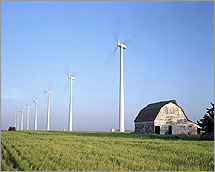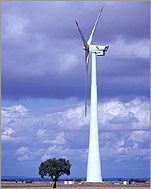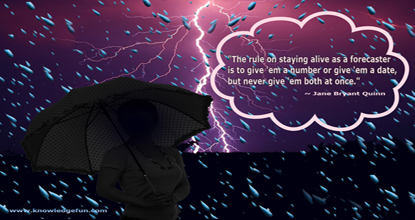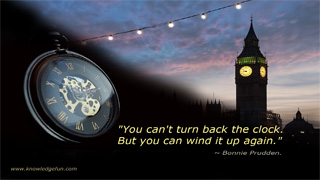Wind Turbines
Types & Sizes of Wind Turbines
Types Of Wind Turbines
Modern wind turbines fall into two basic groups: the horizontal-axis variety, as shown in the photo, and the vertical-axis design, like the eggbeater-style Darrieus model, named after its French inventor.
Horizontal-axis wind turbines typically either have two or three blades. These three-bladed wind turbines are operated "upwind," with the blades facing into the wind.

Many wind farms have sprung up in the Midwest in recent years, generating power for utilities.
Farmers benefit by receiving land lease payments from wind energy project developers.

Sizes of Wind Turbines
Utility-scale turbines range in size from 100 kilowatts to as large as several megawatts. Larger turbines are grouped together into wind farms, which provide bulk power to the electrical grid.
Single small turbines, below 100 kilowatts, are used for homes, telecommunications dishes, or water pumping. Small turbines are sometimes used in connection with diesel generators, batteries, and photovoltaic systems. These systems are called hybrid wind systems and are typically used in remote, off-grid locations, where a connection to the utility grid is not available.
GE Wind Energy's 3.6 megawatt wind turbine is one of the largest prototypes ever erected. Larger wind turbines are more efficient and cost effective.

INFORMATION SOURCE: Information From U.S. Department of Energy - Energy Efficiency and Renewable Energy Wind and Hydropower Technologies Program
We do not inherit the Earth from our ancestors — we borrow it from our children.
:: What You Should Know ::
Winds are caused by the uneven heating of the atmosphere by the sun, the irregularities of the earth's surface, and rotation of the earth.Wind flow patterns are modified by the earth's terrain, bodies of water, and vegetation.
Humans use this wind flow, or motion energy, for many purposes: sailing, flying a kite, and even generating electricity.
The terms wind energy or wind power describe the process by which the wind is used to generate mechanical power or electricity.
Wind turbines convert the kinetic energy in the wind into mechanical power.
This mechanical power can be used for specific tasks (such as grinding grain or pumping water) or a generator can convert this mechanical power into electricity.
"The path towards sustainable energy sources will be long and sometimes difficult. But America cannot resist this transition, we must lead it. We cannot cede to other nations the technology that will power new jobs and new industries, we must claim its promise. That’s how we will maintain our economic vitality and our national treasure—our forests and waterways, our crop lands and snow-capped peaks. That is how we will preserve our planet, commanded to our care by God. That’s what will lend meaning to the creed our fathers once declared."
~ Barack Obama





